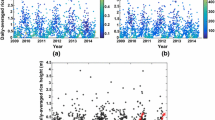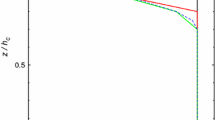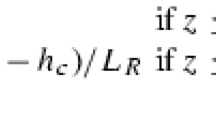Abstract
The mean flow and scalar concentration profiles within and above a tall canopy are well known to violate the standard boundary-layer flux-gradient relationships. We present a theory for the scalar concentration profile that is comprised of a canopy exchange model coupled to a modified surface-layer model. The coupling between the two components and the modifications to the surface-layer profiles are formulated through the mixing-layer analogy for the flow at canopy top. This analogy provides an additional length scale—the vorticity thickness—upon which the profiles depend and a set of criteria that allows a reduction in the empiricism associated with earlier forms in the literature. Predictions of the mean scalar concentration profiles are shown to match observations over a wide range of diabatic stabilities for both potential temperature and water vapour.
Similar content being viewed by others
Abbreviations
- a :
-
Frontal leaf area per unit volume (m2 m−3)
- c d :
-
Drag coefficient at the leaf level
- c * :
-
Scale of the turbulent scalar concentration fluctuations above the canopy
- C :
-
Time and spatially averaged scalar concentration
- C h :
-
Value of C at canopy top
- C 0 :
-
Reference scalar concentration
- d t :
-
Virtual origin for profiles above the canopy
- \({\tau \ \ (F_{c})}\) :
-
Vertical flux of momentum (scalar C)
- F D :
-
Kinematic drag force (m s−2)
- f :
-
Parameter for the within-canopy scalar concentration profile
- g c :
-
Leaf level boundary-layer conductance for scalar transfer
- K m (K c ):
-
Turbulent diffusivity for the vertical momentum (scalar) flux (m2 s−1)
- l m (l c ):
-
Mixing length for the vertical turbulent momentum (scalar) flux (m)
- ℓ m (ℓ c ):
-
Value of l m (l c ) within the canopy
- L :
-
Obukhov length (m)
- L c :
-
Length scale for the absorption of momentum by the canopy (m)
- r :
-
Leaf level Stanton number (Nusselt number if heat is the scalar)
- S c (z):
-
Turbulent Schmidt number (as a function of height)
- S cc (P tc ):
-
Turbulent Schmidt number at canopy top (Prandtl number if heat is the scalar)
- S χ :
-
Source/sink of scalar
- u * :
-
Friction velocity (m s−1)
- U :
-
Time and spatially averaged profile of wind speed (m s−1)
- U h :
-
Value of U at canopy top
- z :
-
Vertical co-ordinate with the origin at canopy top
- z0m (z0c ):
-
Roughness length for momentum (scalar concentration)
- β (β N ):
-
u*/U h (value of β in neutral conditions)
- κ :
-
von Karman constant
- ρ :
-
Density of air (kg m−3)
- \({\phi_{m} \ \ (\phi_{c})}\) :
-
MOST stability functions for momentum (scalar)
- \({\hat{\phi}_{m} \ \ (\hat{\phi}_{c})}\) :
-
RSL function for momentum (scalar)
- \({\phi_{m} \ \ (\phi_{c})}\) :
-
Generalized stability functions for momentum (scalar)
- \({\psi_{m} \ \ (\psi_{c})}\) :
-
Integrated forms of the MOST stability functions
- \({\hat{\psi}_{m} \ \ (\hat{\psi}_{c})}\) :
-
Integrated forms of the RSL functions
References
Ayotte KW, Finnigan JJ, Raupach MR (1999) A second-order closure for neutrally stratified vegetative canopy flows. Boundary-Layer Meteorol 90: 189–216
Baldocchi D, Finnigan J, Wilson K, Paw UKT, Falge E (2000) On measuring net ecosystem carbon exchange over tall vegetation on complex terrain. Boundary-Layer Meteorol 96: 257–291
Belcher SE, Jerram N, Hunt JCR (2003) Adjustment of a turbulent boundary layer to a canopy of roughness elements. J Fluid Mech 488: 369–398
Belcher SE, Finnigan JJ, Harman IN (2008) Flows through canopies in complex terrain. Ecol Appl 18(6): 1436–1453
Bohm M, Finnigan JJ, Raupach MR (2000) Dispersive fluxes and canopy flows: just how important are they? In: Proceedings of the 24th conference on agricultural and forest meteorology. Amer Meteorol Soc, Davis, CA, pp 106–107
Brown GL, Roshko A (1974) On density effects and large structures in turbulent mixing-layers. J Fluid Mech 64(4): 775–816
Brunet Y, Irvine IR (2000) The control of coherent eddies in vegetation canopies: streamwise structure spacing, canopy shear scale and atmospheric stability. Boundary-Layer Meteorol 94: 139–163
Cellier P, Brunet Y (1992) Flux-gradient relationships above tall plant canopies. Agric For Meteorol 58: 93–117
Chambers AJ, Antonia RA, Fulachier L (1985) Turbulent Prandtl number and spectral characteristics of a turbulent mixing layer. Int J Heat Mass Transfer 28: 1461–1468
Chen F, Schwerdtfeger P (1989) Flux-gradient relationships above tall plant canopies. Q J Roy Meteorol Soc 115: 335–352
Corrsin S (1974) Limitations of gradient transport models in random walks and in turbulence. Adv Geophys 18A: 25–60
Finnigan JJ (1985) Turbulent transport in flexible canopies. In: Hutchinson BA, Hicks BB(eds) The forest-atmosphere interaction. Reidel, Dordrecht, pp 443–480
Finnigan JJ (2000) Turbulence in plant canopies. Annu Rev Fluid Mech 32: 519–571
Finnigan J (2004) Advection and modelling. In: Lee X, Massman W, Law B (eds) Handbook of micrometeorology. A guide for surface flux measurements and analysis, vol 29 of Atmospheric and oceanographic Sciences Library. Kluwer Academic Publishers, Chap. 10, pp 209–244
Finnigan JJ, Belcher SE (2004) Flow over a hill covered with a plant canopy. Q J Roy Meteorol Soc 130: 1–29
Finnigan JJ, Leuning R (2000) Long term measurements-coordinate systems and averaging. In: Proceedings of the international workshop for advanced flux network and flux evaluation, pp 51–56
Finnigan JJ, Raupach MR (1987) Transfer processes in plant canopies in relation to stomatal characteristics. In: Zeiger E, Farquar GD, Cowan IR(eds) Stomatal function. Stanford University Press, Stanford, pp 385–429
Garratt JR (1980) Surface influence on vertical profiles in the atmospheric near-surface layer. Q J Roy Meteorol Soc 96: 211–255
Garratt JR (1983) Surface influence upon vertical profiles in the nocturnal boundary layer. Boundary-Layer Meteorol 26: 68–80
Garratt JR (1992) The atmospheric boundary layer. Cambridge University Press, UK, p 316 pp
Graefe J (2004) Roughness layer corrections with emphasis on SVAT model applications. Agric For Meteorol 124: 237–251
Harman IN, Finnigan JJ (2007) A simple unified theory for flow in the canopy and roughness sublayer. Boundary-Layer Meteorol 123: 339–363
Högström U (1996) Review of some basic characteristics of the atmospheric surface layer. Boundary-Layer Meteorol 78: 215–246
Inoue E (1963) On the turbulent structure of airflow within crop canopies. J Meteorol Soc Jpn 41: 317–326
Jackson PS (1981) On the displacement height in the logarithmic velocity profile. J Fluid Mech 111: 15–25
Juang J-Y, Katul GG, Siqueira MBS, Stoy PS, Palmroth S, McCarthy HR, Kim H-S, Oren R (2006) Modeling nighttime ecosystem respiration from measured CO2 concentration and air temperature profiles using inverse methods. J Geophys Res 111(D11): D08S05
Katul GG, Geron CD, Hsieh C-I, Vidakovic B, Guenther A (1998) Active turbulence and scalar transport near the forest-atmosphere interface. J Appl Meteorol 37: 1533–1546
Katul GG, Finnigan JJ, Poggi D, Leuning R, Belcher SE (2006) The influence of hilly terrain on canopy-atmosphere carbon dioxide exchange. Boundary-Layer Meteorol 118: 189–216
Lai C-T, Katul G, Butnor J, Ellsworth D, Oren R (2002) Modelling night-time ecosystem respiration by a constrained optimization method. Glob Change Biol 8: 124–141
Lalic B, Mihailovic DT, Rajkovic B, Arsenic ID, Radlovic D (2003) Wind profile within the forest canopy and in the transition layer above it. Environ Modell Soft 18: 943–950
Leuning R (2000) Estimation of scalar source/sink distribution in plant canopies using Lagrangian dispersion analysis: corrections for atmospheric stability and comparison with a multilayer canopy model. Boundary-Layer Meteorol 96: 293–314
Leuning R, Cleugh HA, Zegelin SJ, Hughes D (2005) Carbon and water fluxes over temperate Eucalyptus forest and a tropical wet/dry savannah in Australia: measurements and comparison with MODIS remote sensing estimates. Agric For Meteorol 98–99: 645–658
Maxey MR (1982) Distortion of turbulence in flow with parallel streamlines. J Fluid Mech 124: 261–282
Mölder M, Grelle A, Lindroth A, Halldin S (1999) Flux-profile relationships over a boreal forest - roughness sublayer corrections. Agric For Meteorol 98–99: 645–658
Poggi D, Katul GG, Albertson JD (2004) A note on the contribution of dispersive fluxes to momentum transfer within canopies. Boundary-Layer Meteorol 111: 615–621
Physick WL, Garratt JR (1995) Incorporation of a high-roughness lower boundary into a mesoscale model for studies of dry deposition over complex terrain. Boundary-Layer Meteorol 74: 55–71
Rannik Ü (1998) On the surface layer similarity at a complex forest site. J Geophys Res 103(D8): 8685–8697
Rannik U, Keronen P, Hari P, Vesala T (2004) Estimation of forest-atmosphere CO2 exchange by eddy covariance and profile techniques. Agric For Meteorol 126: 141–155
Raupach MR (1979) Anomalies in flux-gradient relationships over forest. Boundary-Layer Meteorol 16: 467–486
Raupach MR (1989a) A practical Lagrangian method for relating scalar concentrations to source distributions in vegetation canopies. Q J Roy Meteorol Soc 115: 609–632
Raupach MR (1989b) Applying Lagrangian fluid mechanics to infer scalar source distributions from concentration profiles in plant canopies. Agric For Meteorol 47: 85–108
Raupach MR (1992) Drag and drag partition on rough surfaces. Boundary-Layer Meteorol 60: 375–395
Raupach MR (1994) Simplified expressions for vegetation roughness length and zero-plane displacement as functions of canopy height and area index. Boundary-Layer Meteorol 71:211–216
Raupach MR, Antonia RA, Rajagopolan S (1991) Rough-wall boundary layers. Appl Mech Rev 44(1): 1–25
Raupach MR, Finnigan JJ, Brunet Y (1996) Coherent eddies and turbulence in vegetation canopies: the mixing layer analogy. Boundary-Layer Meteorol 78: 351–382
Raupach MR, Shaw RH (1982) Averaging procedures for flow within vegetation canopies. Boundary-Layer Meteorol 22: 79–90
Rogers MM (1991) The structure of a passive scalar field with a uniform mean gradient in rapidly sheared homogeneous turbulent flow. Phys Fluids A 3(1): 144–154
Schumann U, Gerz T (1995) Turbulent mixing in stably stratified shear flows. J Appl Meteorol 34: 33–48
Simpson IJ, Thurtell GW, Neumann HH, Den Hartog G, Edwards GC (1998) The validity of similarity theory in the roughness sublayer above forests. Boundary-Layer Meteorol 87: 69–99
Sreenivasan KR, Antonia RA, Chambers AJ (1984) On the variation of the turbulent Prandtl number in shear flows. Int Comm Heat Mass Transfer 11: 497–501
Thom AS, Stewart JB, Oliver HR, Gash JHC (1975) Comparison of aerodynamic and energy budget analysis of fluxes over a pine forest. Q J Roy Meteorol Soc 101: 93–105
Townsend AA (1976) The structure of turbulent shear flow, 2nd edn. Cambridge University Press, Cambridge, p 429
Verhoef A, McNaughton KG, Jacobs AFG (1997) A parameterization of momentum roughness length and displacement height for a wide range of canopy densities. Hydrol Earth Syst Sci 1: 81–91
Younis BA, Berger SA (2006) On predicting the effects of streamline curvature on the turbulent Prandtl number. J Appl Mech 73: 391–396
Author information
Authors and Affiliations
Corresponding author
Rights and permissions
About this article
Cite this article
Harman, I.N., Finnigan, J.J. Scalar Concentration Profiles in the Canopy and Roughness Sublayer. Boundary-Layer Meteorol 129, 323–351 (2008). https://doi.org/10.1007/s10546-008-9328-4
Received:
Accepted:
Published:
Issue Date:
DOI: https://doi.org/10.1007/s10546-008-9328-4




